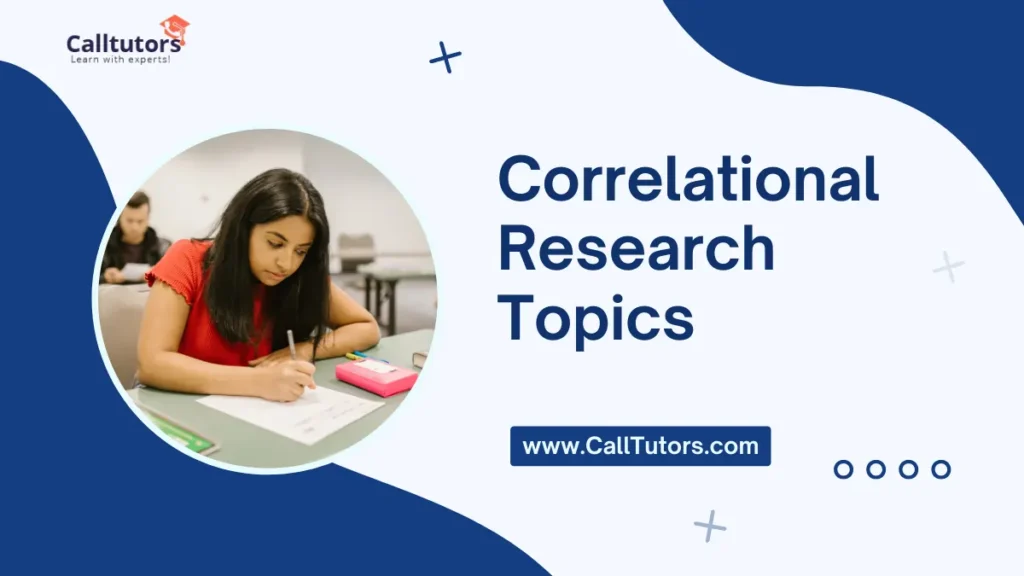Welcome to our blog, Correlational Research Topics! Research about connections is important for understanding how changes in one thing can relate to changes in another. But it does not mean one thing causes the other. This blog will cover the basics of research on connections.
This includes what connections mean and different types of connections. We’ll also discuss what impacts connections and why carefully picking research topics matters. Plus, we’ll give examples of connection research topics in different fields. We’ll show why they’re important and could make a difference.
Whether you’re a student looking for research ideas or want to know about connections in the real world, this blog aims to give helpful ideas and motivation for your journey into connection research. Let’s dive in to learn correlational research topics!

What is Correlational Research?
Table of Contents
Correlation research studies how changes in one thing relate to changes in another. It looks at how two things are connected and if they change together. For example, studying whether people’s income and their level of education are correlated.
Correlation research does not prove cause and effect. It shows relationships between things but not why they are related. More studies are needed to determine if one thing causes the other. Correlation research helps reveal trends and patterns between variables.
How to Select Correlational Research Topics
Here are some simple tips for choosing a good topic for correlational research:
- Pick two things you think are related, like age and memory or exercise and mood.
- Ensure you can measure these things with numbers, like hours exercised per week or the number of words remembered.
- Don’t try to prove one thing causes another; just look at how they are related.
- Pick timely topics that matter right now.
- Look at past research to get ideas and find gaps to fill.
- Think about questions you have about how certain things are connected.
- Look through research databases to find studies on relationships you’re curious about.
- Choose things that naturally connect in the real world, not random things.
The main goal is to pick two things you can measure that somehow seem to relate to each other. Spend time thinking of ideas before settling on a topic.
150+ Correlational Research Topics For Students
Here are over 150 correlational research topics categorized into different fields for students:
Psychology
- The correlation between self-esteem and educational achievement among high school students.
- Relationship between self-esteem and social media usage in college students.
- Correlation between personality traits and career success.
- Impact of parental attachment styles on romantic relationships in young adults.
- Relationship between stress levels and sleep quality among university students.
- Correlation between emotional intelligence and leadership effectiveness.
- The connection between involvement of parents and academic performance in elementary school children.
- Correlation between anxiety levels and academic performance in college students.
- Relationship between attachment styles and childhood trauma in adulthood.
- Correlation between mindfulness practices and stress reduction among college students.
| Also Read:- Criminology Research Topics |
Education
- The correlation between teacher-student rapport and student engagement in the classroom.
- Relationship between homework completion rates and academic achievement.
- Correlation between classroom environment and student motivation.
- Impact of involvement of parents in education on student performance.
- Relationship between school climate and student behavior.
- Correlation between extracurricular activities and academic success.
- The relationship between teacher feedback and pupil learning outcomes.
- Correlation between technology usage and academic performance.
- Relationship between school resources and student achievement.
- Correlation between bullying experiences and academic performance.
Sociology
- The correlation between the status of socioeconomic and access to healthcare.
- Relationship between family structure and juvenile delinquency rates.
- Correlation between media representation and cultural perceptions.
- Impact of community involvement on crime rates.
- Relationship between religion and political affiliation.
- Correlation between social support networks and mental health outcomes.
- Relationship between gender roles and career choices.
- Correlation between immigration rates and cultural assimilation.
- Relationship between income inequality and social mobility.
- Correlation between social media usage and social interaction patterns.
Economics
- The correlation between growth of GDP and unemployment rates.
- Relationship between inflation rates and consumer spending.
- Correlation between government spending and economic growth.
- Impact of trade policies on economic development.
- Relationship between interest rates and investment behavior.
- Correlation between income inequality and economic stability.
- Relationship between education levels and income disparity.
- Correlation between taxation policies and income distribution.
- Impact of globalization on income inequality.
- Relationship between poverty rates and access to healthcare.
Health and Medicine
- The correlation between exercise frequency and mental health outcomes.
- Relationship between diet quality and cardiovascular health.
- Correlation between habits of smoking and lung cancer rates.
- Impact of sleep duration on physical health.
- Relationship between anxiety levels and immune system function.
- Relationship between vaccination rates and disease prevalence.
- Correlation between air pollution and respiratory diseases.
- Impact of social support networks on recovery from illness.
- Relationship between alcohol consumption and liver health.
Environmental Science
- The correlation between deforestation and biodiversity loss.
- Relationship between greenhouse gas emissions and world temperatures.
- Correlation between water pollution levels and aquatic biodiversity.
- Impact of urbanization on air quality.
- Relationship between waste management practices and environmental sustainability.
- Correlation between agricultural practices and soil erosion rates.
- Relationship between renewable energy usage and carbon emissions.
- Correlation between climate change and natural disasters.
- Impact of plastic pollution on marine ecosystems.
- Relationship between population growth and resource depletion.
Business and Management
- The correlation between employee satisfaction and productivity.
- Relationship between leadership styles and team performance.
- Correlation between employee training programs and job satisfaction.
- Impact of organizational culture on employee turnover rates.
- Relationship between customer satisfaction and business profitability.
- Correlation between marketing strategies and customer retention.
- Relationship between the corporate social responsibility and brand reputation.
- Correlation between employee diversity and innovation.
- Impact of supply chain management practices on company performance.
- Relationship between economic indicators and stock market fluctuations.
Technology and Society
- The correlation between social media usage and loneliness feelings.
- Relationship between screen time and attention span in children.
- Correlation between video game usage and aggression levels.
- Impact of smartphone usage on sleep quality.
- Relationship between the online concerns of privacy and social media usage.
- Correlation between digital literacy skills and academic performance.
- Relationship between technology adoption rates and generational differences.
- Correlation between Internet access and economic development.
- Relationship between online shopping habits and environmental sustainability.
- Correlation between technology usage and mental health outcomes.
Sports and Exercise Science
- The correlation between physical activity levels and cardiovascular health.
- Relationship between nutrition habits and athletic performance.
- Correlation between training intensity and muscle growth.
- Impact of sleep quality on athletic recovery.
- Relationship between exercise frequency and mental well-being.
- Correlation between sports participation and academic performance.
- Relationship between injuries in sports and long-term health outcomes.
- Correlation between coaching styles and athlete motivation.
- Impact of sports specialization on injury risk.
- Relationship between exercise adherence and weight management.
Media and Communication
- The correlation between media consumption habits and political beliefs.
- Relationship between advertising exposure and consumer behavior.
- Correlation between news coverage and public opinion.
- Influence of social media influencers on buying decisions.
- The connection between critical thinking skills and media literacy.
- Correlation between television viewing habits and body image issues.
- Relationship between media representation and societal norms.
- Correlation between online communication and interpersonal relationships.
- Relationship between media exposure and aggression in children.
- Correlation between streaming services usage and traditional media consumption.
| Also Read:- Phenomenological Research Topics |
Arts and Culture
- The correlation between education in arts and academic achievement.
- Relationship between cultural experiences and empathy levels.
- Correlation between music preferences and personality traits.
- Impact of cultural diversity on creative industries.
- Relationship between art participation and mental health outcomes.
- Correlation between museum attendance and community engagement.
- Relationship between literature consumption and empathy development.
- Correlation between cultural events attendance and social cohesion.
- Impact of arts funding on community development.
- Relationship between artistic expression and emotional well-being.
Political Science
- The correlation between voter turnout and socioeconomic status.
- Relationship between political ideology and environmental policies.
- Correlation between campaign spending and election outcomes.
- Impact of political polarization on civic engagement.
- Relationship between media bias and public perception of political issues.
- Correlation between government transparency and public trust.
- Relationship between political party cooperation and attitudes towards immigration.
- Correlation between political rhetoric and hate crime rates.
- Relationship between political knowledge and participation in democratic processes.
- Correlation between lobbying efforts and policy outcomes.
Law and Justice
- The correlation between socioeconomic status and incarceration rates.
- Relationship between sentencing disparities and racial identity.
- Correlation between police presence and crime rates in urban areas.
- Impact of therapeutic programs of justices on recidivism rates.
- Relationship between access to legal representation and court outcomes.
- Correlation between mandatory sentencing laws and prison overcrowding.
- Relationship between drug policy enforcement and addiction rates.
- Correlation between control laws on guns and firearm-related deaths.
- Relationship between immigration policies and crime rates.
- Correlation between juvenile justice interventions and rehabilitation outcomes.
History and Anthropology
- The correlation between archaeological findings and historical narratives.
- Relationship between language diversity and cultural preservation.
- Correlation between migration patterns and cultural diffusion.
- Impact of colonialism on indigenous cultures.
- Relationship between cultural practices and social hierarchy.
- Correlation between climate change and human migration.
- Relationship between trade routes and cultural exchange.
- Correlation between artistic expressions and societal values.
- Relationship between religious beliefs and cultural traditions.
- Correlation between technological advancements and societal change.
Gender Studies
- The correlation between gender stereotypes and career choices.
- Relationship between media representation and gender norms.
- Correlation between gender wage gap and educational attainment.
- Impact of gender individuality on mental health outcomes.
- Relationship between gender roles and domestic responsibilities.
- Correlation between workplace discrimination and gender diversity.
- Relationship between feminism and political participation.
- Correlation between LGBTQ+ rights advocacy and social acceptance.
- Relationship between gender-based violence and cultural attitudes.
- Correlation between gender equity policies and workplace satisfaction.
Miscellaneous
- The correlation between pet ownership and mental health.
- Relationship between travel experiences and cultural awareness.
- Correlation between volunteering activities and life satisfaction.
- Impact of hobbies on stress management.
- Relationship between religious beliefs and charitable giving.
- Correlation between language proficiency and cognitive abilities.
- Relationship between parenting styles and child development results.
- Correlation between financial literacy and money management skills.
- Correlation between social network size and happiness levels.
These correlational research topics cover a wide range of areas and can inspire students looking to conduct correlational research in various fields.
Challenges and Limitations
Here are some simple challenges with correlational research:
- It can’t prove one thing causes another, only that things are related.
- Other factors could affect the relationship you see between the two things you’re studying.
- Hard to know which thing impacts the other or if they impact each other.
- Just because two things are correlated does not mean they have a strong relationship. The correlation could be weak.
- Uses observational data, so there is less control than in experiments.
- This might not apply to everyone, only the group studied.
- People may not be honest or accurate if they self-report data like in surveys.
In summary, correlational research can only show two things that relate in some way but can’t prove causation or account for other factors that might affect the relationship. The results may only apply to the sample studied, too. These are good limitations to be aware of.
Best Practices for Correlational Research
Here are some best practices for conducting quality correlational research:
- Use a large random sample representing the population you want to generalize to. This strengthens the external validity of your findings.
- Measure variables accurately and reliably using validated instruments. Poor measurement can obscure relationships.
- Collect data prospectively, if possible, rather than retrospectively. This avoids reliance on recollection.
- Use multiple data points over time (longitudinal data) rather than a single data collection. This provides more insight into relationships.
- Examine curvilinear relationships in addition to linear ones. The correlation may only occur at certain levels.
- Control statistically for potential third variables that may influence the relationship. This provides a clearer assessment of the relationship.
- Assess directionality and potential interactive or reciprocal relationships using path analysis or longitudinal data. This provides greater understanding.
- Use multiple regression techniques to model more complex relationships among many variables.
- Report effect sizes and confidence intervals, not just statistical significance. Effect size indicates practical importance.
- Cautiously interpret results and do not overstate causality claims. Correlation does not equal causation.
- Replicate findings using different samples to assess generalizability and consistency.
Following best practices strengthens correlational research’s rigor, analysis, and interpretation. Adhering to these can produce higher-quality studies.
| Also Read:- AP Research Topics |
Final Remarks
Studying correlational research topics can help us learn much about how different things are related. Psychology, education, and business students can pick topics to research and find interesting connections. They can learn if certain things appear to go up or down together. This can give useful information to help make decisions or create policies.
When students carefully choose a correlational research topic and study the data, they can add to what we know about real-world relationships. For example, they may find links between sleep and grades, exercise and mood, or class size and learning.
Doing correlational research allows students to spot patterns between things and practice research skills. As they choose their topics, students can find exciting areas to explore. Uncovering correlations teaches us more about the complicated links between things in the world around us. With simple hard work, students can use correlational research to reveal new insights.



